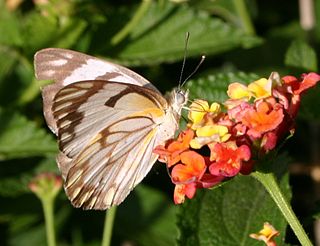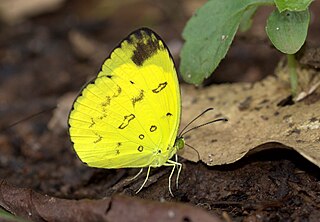
The green-veined white is a butterfly of the family Pieridae.

The Pieridae are a large family of butterflies with about 76 genera containing about 1,100 species, mostly from tropical Africa and tropical Asia with some varieties in the more northern regions of North America and Eurasia. Most pierid butterflies are white, yellow, or orange in coloration, often with black spots. The pigments that give the distinct coloring to these butterflies are derived from waste products in the body and are a characteristic of this family. The family was created by William John Swainson in 1820.

Pierini is a tribe of butterflies within the family Pieridae.

Euchloe ausonia, the eastern dappled white, is a southern European and Palearctic butterfly found mostly to the south and east of its almost indistinguishable relative the western dappled white.

Eurema andersonii, the one-spot grass yellow or Anderson's grass yellow, is a small butterfly of the family Pieridae, that is, the yellows and whites, which is found in India, Myanmar and other parts of Asia.

Eurema nilgiriensis, the Nilgiri grass yellow, is a small butterfly of the family Pieridae, that is, the yellows and whites, which is found in south India.

Colias eurytheme, the orange sulphur, also known as the alfalfa butterfly and in its larval stage as the alfalfa caterpillar, is a butterfly of the family Pieridae, where it belongs to the lowland group of "clouded yellows and sulphurs" subfamily Coliadinae. It is found throughout North America from southern Canada to Mexico.

Mud-puddling, or simply puddling, is a behaviour most conspicuous in butterflies, but also occurring in other animals, primarily insects. The organism seeks out nutrients in certain moist substances such as rotting plant matter, mud, and carrion, and sucks up the fluid. Where the conditions are suitable, conspicuous insects such as butterflies commonly form aggregations on wet soil, dung, or carrion. From the fluids they obtain salts and amino acids that play various roles in their physiology, ethology, and ecology. This behaviour also has been seen in some other insects like the leafhoppers, e.g. the potato leafhopper, Empoasca fabae.
Butterfly evolution is the origin and diversification of butterflies through geologic time and over a large portion of the Earth's surface. The earliest known butterfly fossils are from the mid Eocene epoch, between 40-50 million years ago. Their development is closely linked to the evolution of flowering plants, since both adult butterflies and caterpillars feed on flowering plants. Of the 220,000 species of Lepidoptera, about 45,000 species are butterflies, which probably evolved from moths. Butterflies are found throughout the world, except in Antarctica, and are especially numerous in the tropics; they fall into eight different families.

George Talbot FES was an English entomologist who specialised in butterflies. He wrote about 150 scientific papers, the majority being primarily systematic, consisting of the description of new species or the revision of various genera. He was also responsible for the curation and preservation of the Joicey collection of Lepidoptera prior to its accession by the Natural History Museum.
Harish (Honnayya) S. Gaonkar is an Indian specialist on butterflies who contributed to the Zoological Museum at the University of Copenhagen, Denmark and wrote a 1996 compilation of butterflies of Western Ghats, South India cataloguing 330 species. Gaonkar earned his PhD from the University of California, Berkeley.
Butterflies, or members of the Papilionoidea superfamily, use two ultraviolet signals, UV reflectance or absorbance as a communication system. The ultraviolet region is the part of the electromagnetic spectrum between 10 nm and 400 nm in wavelength. Sensitivity to this region provides butterflies several benefits such as nectar guides for nectar, but it also provides a private communication channel unavailable to predators. With this secure line, butterflies are able to facilitate mating behavior and sex recognition.

Ascia is a genus of butterflies in the family Pieridae. It is monotypic, being represented by the single species Ascia monuste, commonly known as the great southern white, In this species the sexes may differ with the female being either light or dark colored. It is found from the Atlantic and Gulf coasts of the United States, and south to Argentina. It is migratory along the south-eastern coast of the United States, with strays to Maryland, Kansas, and Colorado.

Pereute leucodrosime, the red banded pereute, is a butterfly of the family Pieridae.

Catopsilia florella, the African migrant, African emigrant, or common vagrant, is a butterfly of the family Pieridae. It is found in Africa, Arabia and the Canary Islands. Like Catopsilia pomona, this species also has a habit of migration.Many early authors mentioned the presence of this species in Asia; but those were probably due to confusion arises as Catopsilia pyranthe females exhibit a lot of seasonal variations. Catopsilia florella is not included as a species in India in any recent checklists.

Dismorphia amphione, the tiger mimic white, is a species of butterfly of the family Pieridae. It is found from Mexico and the Caribbean down to Brazil and Bolivia.

Leptophobia aripa, the common green-eyed white or mountain white, is a butterfly in the family Pieridae. It is native to Mexico, Central America and South America, but strays may be found as far north as southern Texas.

Eucheira socialis, commonly known as the Madrone butterfly is a lepidopteran that belongs to the family Pieridae. It was first described by John O. Westwood in 1834. Locally known as Mariposa del madroño or tzauhquiocuilin, it is endemic to the highlands of Mexico, and exclusively relies on the Madrone as a host-plant. The species is of considerable interest to lepidopterists due to gregarious nest-building in the larval stages, and heavily male-biased sex ratio. It takes an entire year for this adult butterfly to develop from an egg. The eggs are laid in the month of June and the adults emerge the following May–June. The adults have a black and white pattern on their wings, and the males are generally much smaller and paler than the females. The larvae do not undergo diapause and continue to feed and grow communally in the coldest months of the year. There are two subspecies of E. socialis, named E. socialis socialis and E. socialis westwoodi.

Pereute is a Neotropical genus of butterflies in the family Pieridae.

Pereute callinira is a butterfly of the family Pieridae.
















